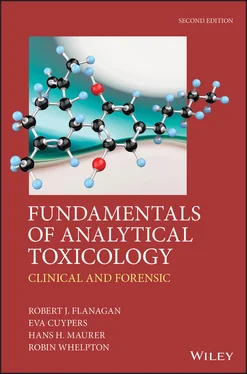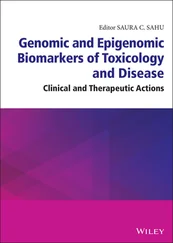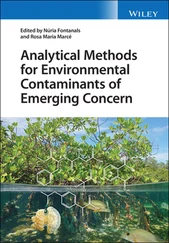Information recorded on the sample container at the time the sample is collected should include the name of the patient (first and family or last name) and date of birth, patient/subject/animal number, the date and time of collection, and the sample type. Many laboratories will have a bespoke analysis request form to accompany the sample(s) on which this and any other appropriate information such as a note of any preservative added to the sample, site of collection of blood, etc. should be recorded ( Box 2.2). The date and time of receipt of all specimens by the laboratory should be recorded and a unique identifying number assigned in each case.
Table 2.5 Sample requirements: post-mortem biochemistry and toxicology
| Sample |
Notes a |
| Heart whole blood (right ventricle) |
20 mL unpreserved (normally qualitative toxicology only) |
| Jugular vein whole blood |
20 mL unpreserved (normally qualitative toxicology only) |
| Peripheral whole blood |
20 mL from femoral or other peripheral site ensuring no contamination from urine or from central or cavity blood. Collect one portion into 2 % w/v sodium fluoride and another into a plain tube |
| Urine |
20–50 mL if available (plain tube, no preservative unless a portion is required for ethanol measurement) |
| Gastric contents b |
25–50 mL (plain bottle, no preservative; record the total weight or volume) |
| Vitreous humour |
Maximum available, plain tube, separate specimens from each eye if feasible. Avoid excessive suction to minimize the risk of aspirating retinal fragments. Collect one portion into 2 % w/v sodium fluoride if for ethanol measurement |
| Cerebrospinal fluid |
5–10 mL, plain tube |
| Pericardial fluid |
Maximum available, plain tube |
| Synovial fluid c |
Maximum available, plain tube |
| Intra-osseous fluid |
Maximum available, plain tube |
| Bile |
Maximum available, plain tube |
| Liver and other tissues |
Liver 10 g (deep inside right lobe), other tissues 10 g as appropriate d |
| Scene residues e |
As appropriate |
aSmaller volumes may often be acceptable, for example in the case of young children
bIncludes vomit, gastric lavage (SWO, first sample), etc.
cAlternative if vitreous humour not available
dBecause there is little information on drug distribution within solid tissues in man, collection of approximately 10 g specimens from several sites from organs such as the brain is recommended if the whole organ is available
eTablet bottles, drink containers, aerosol canisters, etc. should be packed entirely separately from biological samples, especially if poisoning with volatiles is a possibility
Table 2.6 Advantages and disadvantages of different sample types in analytical toxicology
| Specimen |
Advantage |
Disadvantage |
Comment |
| Blood (plasma/serum or whole blood) |
Detect parent compound. Interpretation of quantitative data |
Limited volume. Low concentrations of many basic drugs and some other poisons |
Interpretation of quantitative results from post-mortem blood may be difficult |
| Dried blood spot on filter paper |
If known volume of venous blood added, then easy to store and transport (room temperature) |
Almost impossible to get accurate volume of blood without use of a pipette or special device. Need analyte to be stable on the paper |
Advocated for collecting capillary blood, but capillary blood not venous blood |
| Urine |
Often large volume.High concentrations of many poisons, but sometimes only metabolites detectable |
Not always available. Quantitative data not often useful |
Standard sample for substance misuse screening |
| Gastric aspirate (stomach contents, SWO, vomit, etc.) |
May contain large amounts of poison, particularly if ingested |
If available, variable sample. Limited use if exposure is by inhalation or injection |
Ensure no cross-contamination of other specimens during transport/storage/analysis |
| Oral fluid |
Non-invasive. Qualitative information on exposure to many drugs |
Variable sample hence little use for quantitative work. Low concentrations of many analytes |
Interpretation of quantitative results may be difficult |
| Hair/nails or nail clippings |
Usually available even if decomposition advanced |
High sensitivity needed. May only give exposure data for the weeks/months before death. Susceptible to external contamination |
Easy to store (room temperature) |
| Exhaled air |
Non-invasive. Large volume available |
Need live patient. Analyte must be volatile or present as an aerosol |
Mainly used to assess ethanol ingestion, carbon monoxide exposure, and monitor volatile anaesthetics |
| Scene residues (tablet bottles, aerosol cans, etc. near patient) |
May contain large amounts of poison |
May not have been the poison taken |
Ensure no cross-contamination of other specimens during transport/storage/analysis |
| Vitreous humour |
May be used instead of urine if latter not available |
Limited volume but normally two specimens |
Analysis may be valuable to help interpret post-mortem blood data for ethanol and for some other compounds |
| Additional tissues (liver, brain, lung, kidney, etc.) |
May contain large amounts of poison.If available then large quantity |
Interference in analysis.Difficult to prepare calibrators/QCs, assess recovery, etc. Quantitative data not always easy to interpret |
Analysis may be valuable to help interpret post-mortem blood data |
Box 2.2Information that should accompany a request for general toxicological analysis
Name, sex, date of birth, date and time of death if appropriate, details of the sample(s) sent for analysis
Name, address, and telephone number of clinician/pathologist and/or coroner's/police officer requesting the analysis, and address to which the report and invoice are to be sent. A post-mortem (reference) number may also be appropriate
Circumstances of incident (including copy of sudden death report if available)
Past medical history, including current or recent prescription medication, and details of whether the patient suffered from any serious potentially infectious disease such as hepatitis, tuberculosis, or HIV
Information on the likely cause, and estimated time, of ingestion/death and the nature and quantity of any substance(s) implicated
If the patient has been treated in hospital, a summary of the relevant hospital notes should be supplied to include details of emergency treatment and drugs given, including drugs given incidentally during investigative procedures
Note of occupation/hobbies
A copy of any preliminary pathology report, if available
2.3.1 Sample collection and preservation
In general biological specimens should ideally be stored at 2–8 °C before transport to the laboratory. Exceptions to this include hair, nail, and filter-paper adsorbed DBS. Dried blood stains and other dried forensic specimens may of course be handled similarly (Schütz et al ., 2002).
Each specimen bottle should be securely sealed to prevent leakage, and individually packaged in separate plastic bags. Particular attention should be paid to the packaging of samples to be transported by either post, or courier in order to comply with current health and safety regulations. Sample volumes or amounts smaller than those indicated in Tables 2.4and 2.5are often sufficient to complete the analyses required. Submission of very small samples may, however, result in reduced sensitivity and scope of the analyses undertaken, but nevertheless such samples should always be forwarded to the laboratory. Any residual specimen should be kept at –20 °C or below until investigation of the incident has been concluded.
Читать дальше












